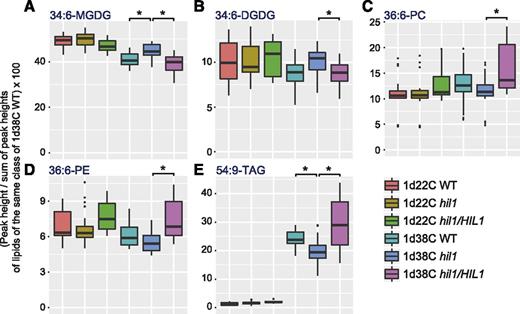Arabidopsis thaliana is widely used as a model plant for plant life science research. Lipidomics techniques using ultra performance liquid chromatography (UPLC) and mass spectrometry (MS) based techniques can be used to analyze lipid metabolites in Arabidopsis models, identify differentially regulated lipids, facilitate plant science mechanism studies, and discover lipid markers.
Case 1 Lipidomics and transcriptomics to study lipid synthesis in plant cell membranes (1)
Temperature and light are important influences that affect the metabolic activity of plant glycerolipids. Low temperature conditions stimulate the desaturation of glycerolipids. High temperatures, on the other hand, induce the synthesis of triacylglycerides on cell membrane lipids. Fatty acid synthesis is restricted under dark conditions and increased when light is strong. In addition, the regulation of metabolic activity of glycerol glycolipids further ensures good physiological and biochemical activity despite new environmental stimuli by influencing the incorporation of plant cell membrane lipids. In this paper, a new multivariate statistical modeling approach, O2PLS, is used to explore how the expression of transcript levels regulates cell membrane lipid synthesis during changes in light and temperature conditions.

Characteristics of O2PLS Latent Variables.
The results revealed that the majority of lipidomics is noise (up to 67.6%) and O2PLS can reduce the effect of noise in a single histology. O2PLS-based analysis focused on the transcriptional regulatory network of lipid metabolism, revealing that plants respond to changes in environmental factors through transcriptional remodeling. The regulation of lipid metabolism by key genes was verified by a knockout approach. Five key genes were identified based on glycerol glycolipid metabolism and verified the effect of key genes on lipid metabolism in the presence of environmental alterations.
Case 2 Lipidomic reveals the response mechanism of heat stress in Arabidopsis (2)
Terrestrial plants are usually subject to heat stress due to climate change. Heat stress increases the fluidity of cell membranes, so plants have evolved a set of regulatory mechanisms that increase their stability by altering the lipid composition of cell membranes to effectively withstand heat stress.
In a previous study, the authors found that heat stress caused a decrease in the content of glycerolipids such as MGDG, which contains polyunsaturated acyl groups, and an increase in the content of PC, DAG and TAG, which contain 18:3 fatty acid acyl chains, in chloroplasts by lipidomics. Transcriptomic data also suggest that heat stress-induced genes are involved in lipid metabolic processes such as TAG synthesis, catabolism and β-oxidation of fatty acids. Therefore, the authors hypothesized that there are also some unidentified genes that encode lipases located in chloroplasts induced by heat stress. Under heat stress they are involved in the catabolic release of 18:3 from chloroplast glycerolipids and promote the synthesis of 18:3-containing TAG.
In this study, differences in lipase expression were first sought at the gene level, and then the HIL gene was selected for in-depth study, and the mechanism of action of HIL was further identified by lipidomics analysis.
The glycerol glycoside composition of wild-type, hil1 mutant and complementary hil1 / HIL1 leaves was compared by lipidomics techniques. A total of 96 lipid molecules were detected in Arabidopsis leaves, 62 of which were detected in all sample species. 34:6-MGDG and 34:6-DGDG showed similar trends, as did 36:6-PC, 36:6-PE, and 54:9-TAG, as shown in Fig. Remodeling of 18:3-containing lipid molecules under heat stress occurred between 34:6-MGDG, 34:6-DGDG, 36:6-PC, 36:6-PE, and 54:9-TAG, a process partially mediated by the function of HIL1.

Profiles of Characteristic Glycerolipid Species in Leaves of the Wild-Type, T-DNA Insertion Mutant, and Complemented Plants under Heat Stress.
Resources
- Szymanski, J., Brotman, Y., et al. (2014). Linking gene expression and membrane lipid composition of Arabidopsis. The Plant Cell, 26(3), 915-928.
- Higashi, Y., Okazaki, Y., et al. (2018). HEAT INDUCIBLE LIPASE1 remodels chloroplastic monogalactosyldiacylglycerol by liberating α-linolenic acid in Arabidopsis leaves under heat stress. The Plant Cell, 30(8), 1887-1905.







